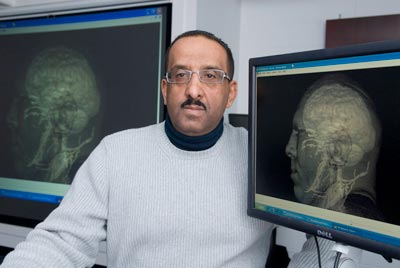
URI Pharmacy professor discovers enhanced Alzheimer’s plaques in monkey tissue
KINGSTON, R.I. — January 9, 2008 – A University of Rhode Island pharmacy professor has found for the first time evidence of Alzheimer’s-like disease in monkeys that were exposed to lead as infants.
Nasser Zawia, a URI professor of biomedical sciences at the College of Pharmacy led the three-year study, which involved four institutions. The findings were published in January’s issue of The Journal of Neuroscience.
“This is the first evidence of promotion of Alzheimer’s disease-like pathology in a primate by an environmental agent,” Zawia said. “It is relevant because monkeys have identical genes to humans.”
In a study begun in 1980, a group of monkeys was given infant formula with low levels of lead for 400 days. A control group was given formula with no lead. No health problems were found in any of the monkeys during the 23-year study. The low level of lead given to one group of monkeys was designed to mimic what children would be exposed to in their environment. By the time of Zawia’s study, there were no detectable levels of lead in the monkey tissue from the group exposed to the toxin.
 In his research, Zawia and his research team discovered Alzheimer’s related genes as well as amyloid plaques associated with the illness in the tissue from the monkeys given lead. These plaques, or protein fragments, would be typically broken down and eliminated, but Alzheimer’s produces hard, insoluble plaques.
In his research, Zawia and his research team discovered Alzheimer’s related genes as well as amyloid plaques associated with the illness in the tissue from the monkeys given lead. These plaques, or protein fragments, would be typically broken down and eliminated, but Alzheimer’s produces hard, insoluble plaques.
While the hazards of lead exposure in children have been well publicized, Zawia’s latest work “provides further proof for a development origin and environmental link for Alzheimer’s disease.”
He said senile plaques were found in all of the adult monkeys, but the ones exposed to lead as infants were more dense and numerous.
The research follows earlier studies by Zawia that demonstrated links between infant exposure to lead and precursors to Alzheimer’s in rats and mice. “We found that when they became adults, the rats’ and mice genes mimicked what happens to genes in humans affected by Alzheimer’s.
“But the problem was, rats don’t develop brain plaques as people do when they are afflicted with Alzheimer’s,” Zawia said.
Through Zawia’s contacts at the National Institutes of Health, he became aware of a study that had been done by Deborah C. Rice, now a toxicologist at the Maine Environmental Protection Agency, on behavioral and cognitive effects on monkeys given low levels of lead in infant formula. She examined the monkeys from infancy to adulthood.
“Dr. Jean Harry, a mentor of mine at NIH, told me about the availability of adult monkey tissue. This was all very serendipitous. I didn’t know Dr. Rice and wasn’t aware of her ongoing study,” Zawia said.
In all, Zawia has been studying the introduction of lead to young mammals and its effects on adult animals for the past eight years. This work has attracted about $700,000 in grants from the National Institutes of Health.
“We were the first to establish a link between developmental lead exposure and Alzheimer’s disease-like pathogenesis. This work took over five years from experiment to publication. Here we provide further proof that is relevant to humans in an animal model that has identical gene sequences and pathologic outcome.
“We believe at some critical developmental window, lead exposure has intervened with control of genes and thus changes the destiny of gene expression in old age,” Zawia said.
Media Contact: Dave Lavallee, 401-874-5862

